Diamond Sturgeon (Acipenser gueldenstaedtii)
Video by mossemer
The Diamond Sturgeon (Acipenser gueldenstaedtii) is often sold as a hybrid but is a true species. It is the most popular sturgeon seen for sale but is really not suitable for small ponds.![]()
It can reach 2.3m and 110kg in the wild but 1.25m and 15kg is nearer the mark in ponds.![]()
It grows very quickly, only second in growth rate to the Beluga. The Diamond Sturgeon is very pretty when small but often loses its white pattern to become a grey/black colour.![]()
The Diamond Sturgeon does not tolerate low oxygen or temperatures over 25C very well at all. Extra oxygenation in the summer months is essential.![]()
Diamond Sturgeons do not tolerate strong treatments such as formalin.
A poor fish when under 20cm in length as it can suffer from White Sturgeon iridovirus (See Health Issues), so only buy larger specimens.![]()
Description
The blunt rounded nose distinguishes it from other species, although there is a variety now appearing for sale with a pointed nose which comes from Germany.![]()
Video by mossemer
Due to its growth rate it must be fed good quality sturgeon food as it suffers very quickly from malnutrition.![]()
The growth rate is dependent on food quality and temperature but when young they can grow very fast, putting on 10 - 12 inches (25 - 30 cm) or more in length over a year, given the right food and environment. The growth rate slows down once the fish has reached about 3ft in length, when it starts to fill out.![]()
Acipenser gueldenstaedtii has 8-18 dorsal scutes, 24-50 lateral scutes, 6-13 ventral scutes, 27-51 dorsal fin rays and 18-33 anal fin rays. The snout is short and rounded at the tip. Skin colour is dark blue to black with white/cream scutes, bony platelets and belly.![]()
Recommended Pond Size
The Diamond Sturgeon is a large impressive fish that will quickly outgrow smaller ponds of 2,000 - 3,000 gallons (9,000 - 13,500 litres) that the Sterlet (Acipenser ruthenus), with their slower growth rate, would do well in for longer.![]()
They may be kept in a pond of 3,000 - 6,000 gallons (13,500 - 27,000 litres) for some time but a pond of 6,000 - 8,000 gallons (27,000 - 36,500 litres) or more is recommended if you want to keep Diamond Sturgeons into maturity.![]()
Many larger Diamond Sturgeons are now being sold privately due to them outgrowing their current ponds.
Food & Feeding
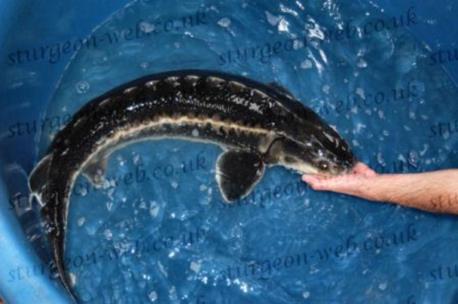
A 110 cm Diamond Sturgeon (Acipenser gueldenstaedtii) about 10kg and 6-7 years old.
Sturgeons DO NOT, as some people would have you believe, eat banket weed or 'clean the bottom of the pond'. Sturgeons need to be fed all year round, they need 2-3% of their body weight of good quality food per day in the summer, less in the winter.![]()
A healthy sturgeon diet must contain a high level of animal protein, sturgeons need a minimum protein content of 40% and an oil level of 15% or more. A a small percentage of the protein can be obtained from soya but the majority needs to be from fishmeal or other animal sources.![]()
Pellet to Sturgeon size:
- 2mm pellet Starter Diet Sturgeon 10-20cm (4-8in)
- 3mm pellet Sturgeon 20-36cm (8-14in)
- 4.5mm pellet - sturgeon size 30-50cm (12-20in)
- 6mm pellet Sturgeon 36-61cm (14-24in)
- 8mm pellet Sturgeon over 61cm (24in)
Stellatus (Acipenser stellatus) and Sterlets (Acipenser ruthenus) have smaller throats; use a size smaller for them.
Buy sturgeon food pellets from Orchard Fisheries »
For more information feeding your sturgeon see our Sturgeon Food and Feeding page.![]()
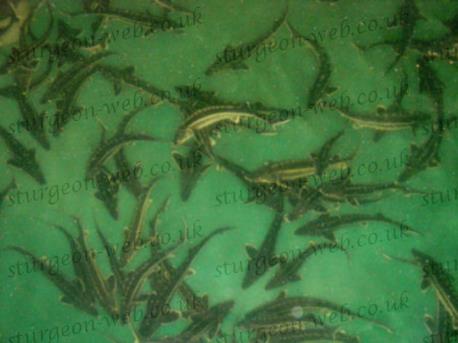
A tank full of small Diamond Sturgeons (Acipenser gueldenstaedtii)
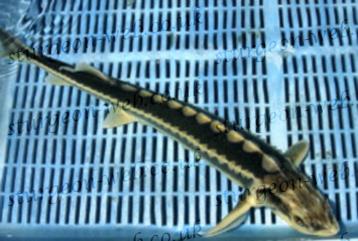
A very good specimen, 90cm long in just 3 years

An unusual young diamond
Health Issues
The Diamond Sturgeon and its hybrids are susceptible to the White Sturgeon iridovirus (WSIV) which is almost always fatal in juveniles. Avoid buying this species under 20cm. Larger specimens are more likely to survive the virus but may still be carriers. ![]()
The most common sturgeon health problems are food and/or oxygen related, get these two vital things right and your sturgeons should remain fit and healthy.![]()
Use an oxygen test kit to make sure there is enough oxygen in the water. Follow the instructions that come with the kit to ensure correct results. Do not assume that there is plenty of air just because you have an air pump running. Many things can affect the amount of dissolved oxygen in the water so testing is the only way to be certain. Warm water holds less oxygen than cold water so be vigilant during hot weather, especially stormy nights when the oxygen may drop to dangerously low levels suddenly.![]()
Feed your sturgeon plenty of the correct food all year round. For more information about feeding your sturgeon see our Sturgeon Food and Feeding page.![]()
Avoid strong chemical treatments such as formalin/formaldehyde, Potassium permanganate, Copper sulphate or any treatment that states not to be used with Golden Orfe (Leciscus sp.) or Rudd (Scardinius reythrophathalmus), these will probably kill your sturgeon. Salt is the safest treatment to use with sturgeons. For more information about treating your sturgeon see our Medications and Treating Sturgeons page.![]()
Provide the best possible water quaility for you fish. Run the pump and filtration all year round and keep a spare back up pump in case of main pump failure. For more information about water quality see our Water Quality page.![]()
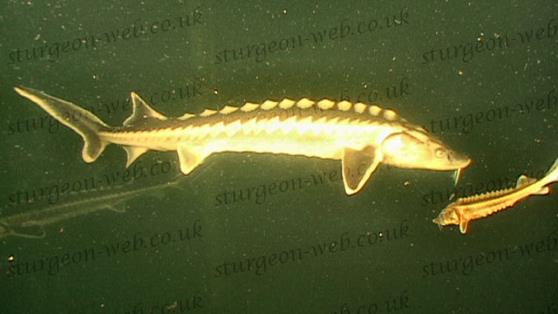
A Picture supplied by Igor Maslyuk
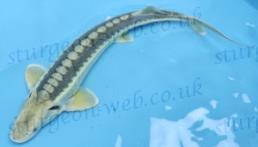
Rare pale Diamond Sturgeon (Acipenser gueldenstaedtii)

Diamond Sturgeon (Acipenser gueldenstaedtii)
Wild distrubution
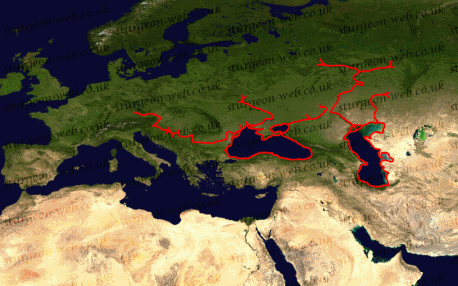
Diamond sturgeon (Acipenser gueldenstaedtii) wild distrubution map
The Diamond sturgeon (Acipenser gueldenstaedtii) is a European species from the Caspian, Black and Sea of Azov basins. It is currently only found in the Caspian Sea, where it spawns in the rivers Ural and Volga, and the Black Sea where spawning occurs in the lower Danube and Rioni rivers. There is no known native spawning population remaining in the Sea of Azov. Intentional and accidental introductions have occured throughout Europe as a result of aquaculture. The Diamond sturgeon is an andronomous species, some migrate in spring to enter freshwater just before spawning while others migrate in autumn to overwinter in rivers and spawn the following spring further upstream.![]()
Acipenser gueldenstaedtii is listed as Critically Endangered on the IUCN Red List of Threatened Species.![]()
Taxonomy
Kingdom: Animalia
Phylum: Chordata
Subphylum: Vertebrata
Superclass: Osteichthyes
Class: Actinopterygii
Subclass: Chondrostei
Order: Acipenseriformes
Suborder: Acipenseroidei
Family: Acipenseridae
Subamily: Acipenserinae
Genus: Acipenser
Common names
Azov-Black Sea Sturgeon, Danube Sturgeon, Diamond Sturgeon, Diamondback Sturgeon, Kura sturgeon, Osetr, Russian sturgeon
Links
Encyclopedia of Life | FAO Species Fact Sheet | Fishbase | ITIS | Pond Life | World Register of Marine Species
Written by Terry White & Graham Quick
Contents
Home
Sturgeon Species
Sturgeon Care
Sturgeon Health
Water Quality
Our Other Sites

Copyright © 2000-2024
www.sturgeon-web.co.uk
All Rights Reserved.
Protected by UK Copyright Service Registration No:311386
